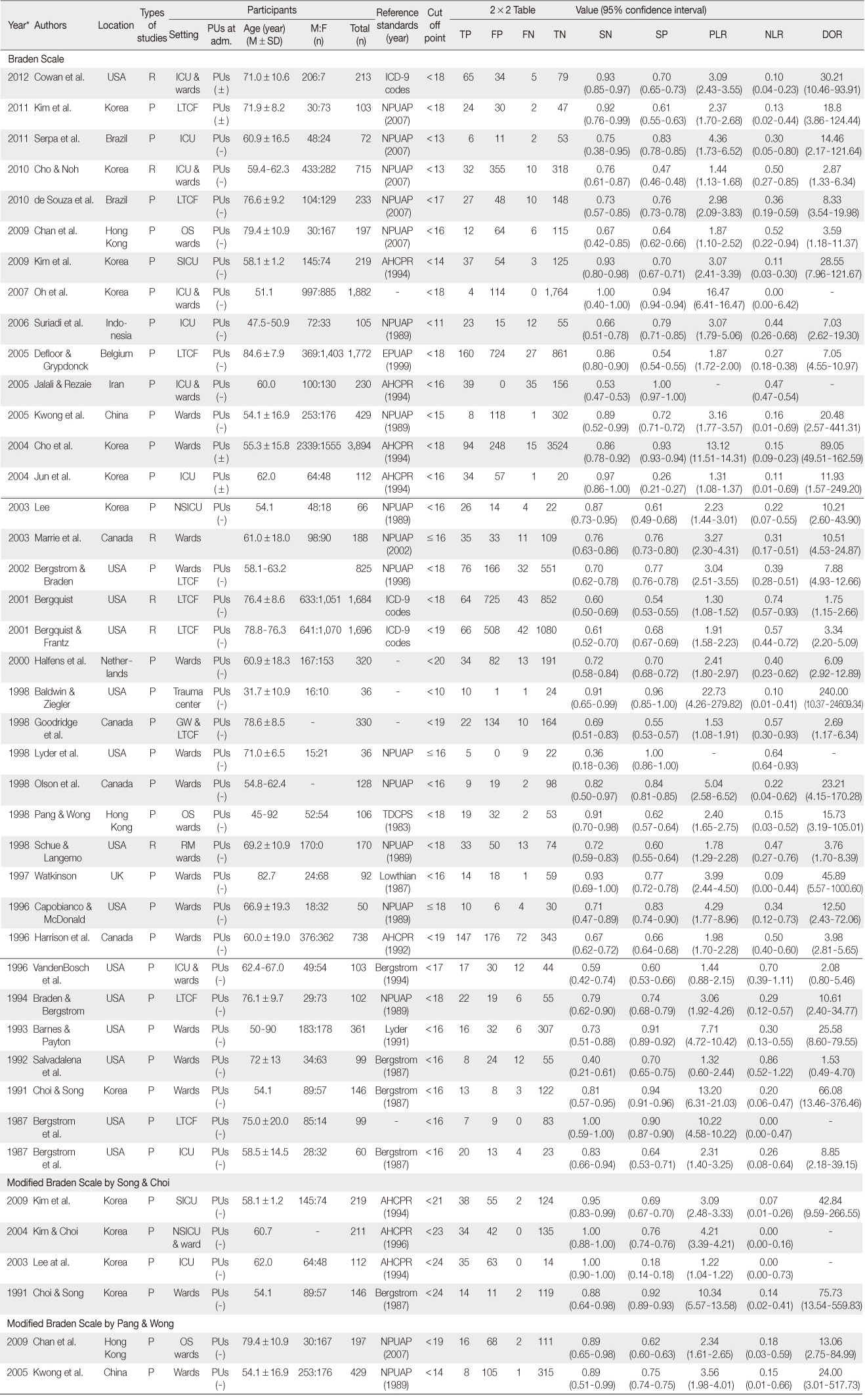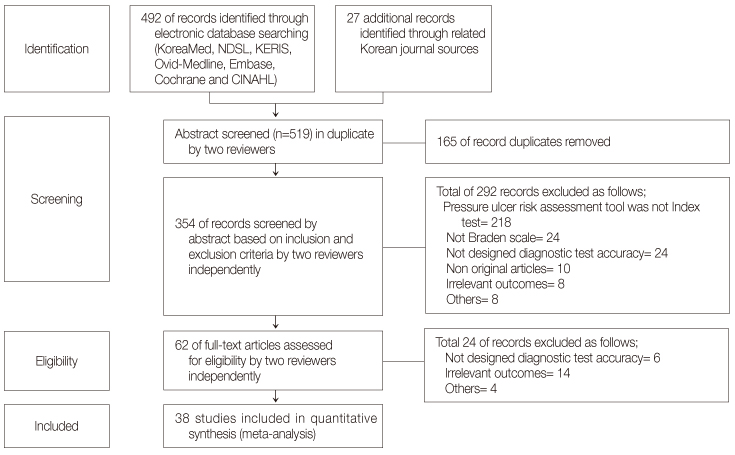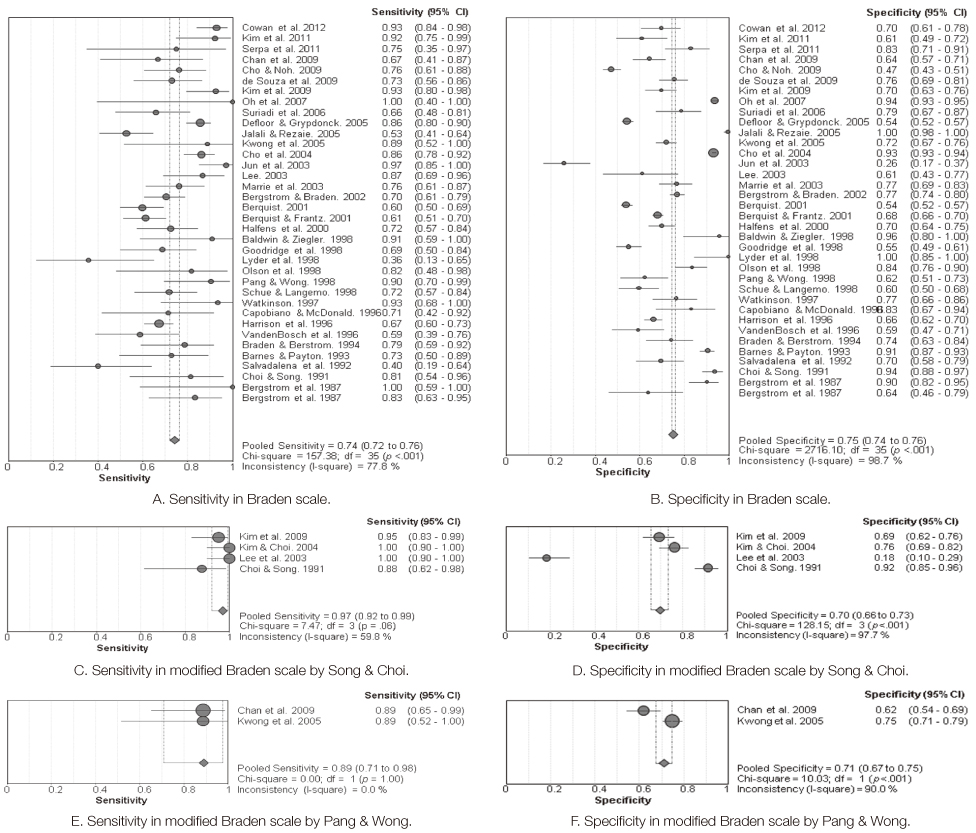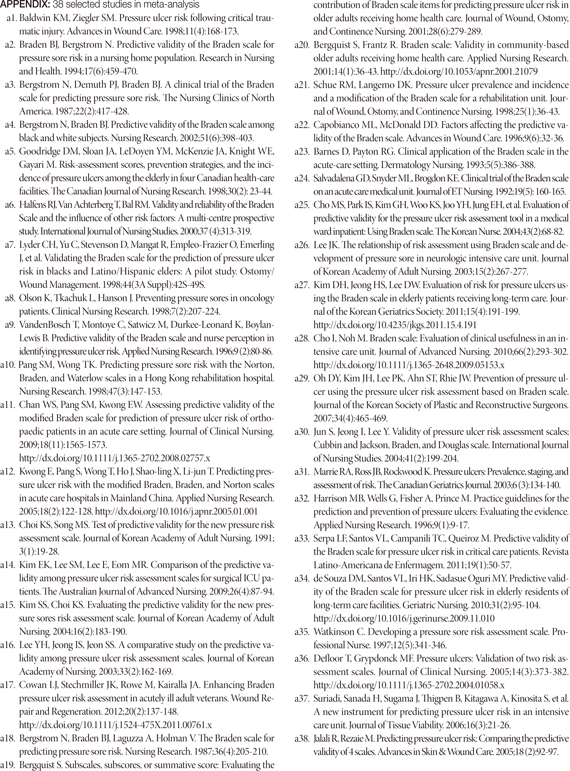Articles
- Page Path
- HOME > J Korean Acad Nurs > Volume 44(6); 2014 > Article
-
Review Article
- Predictive Validity of the Braden Scale for Pressure Ulcer Risk: A Meta-analysis
- Seong-Hi Park, Yu-Sun Park
-
Journal of Korean Academy of Nursing 2014;44(6):595-607.
DOI: https://doi.org/10.4040/jkan.2014.44.6.595
Published online: December 31, 2014
1School of Nursing, Pai Chai University, Daejeon, Korea.
2Quality Improvement Team, Korea University Ansan Hospital, Ansan, Korea.
- Address reprint requests to: Park, Yu-Sun. Quality Improvement Team, Korea University Ansan Hospital, 123 Jeokgeum-ro, Danwon-gu, Ansan 425-707, Korea. Tel: +82-31-412-5577, Fax: +82-31-412-6813, ssun104@hotmail.com
© 2014 Korean Society of Nursing Science
This is an Open Access article distributed under the terms of the Creative Commons Attribution NoDerivs License. (http://creativecommons.org/licenses/by-nd/4.0/) If the original work is properly cited and retained without any modification or reproduction, it can be used and re-distributed in any format and medium.
Abstract
-
Purpose
- The Braden Scale is one of the most intensively studied risk assessment scales used in identifying the risk of developing pressure sore. However, not all studies show that the predictive validity of this scale is sufficient. The purpose of this study was to evaluate the Braden Scale for predicting pressure ulcer development.
-
Methods
- Articles published 1946 and 2013 from periodicals indexed in Ovid Medline, Embase, CINAHL, KoreaMed, NDSL and other databases were selected, using the following keywords: 'pressure ulcer'. The QUADAS-II was applied to assess the internal validity of the diagnostic studies. Selected studies were analyzed using meta-analysis with MetaDisc 1.4.
-
Results
- Thirty-eight diagnostic studies with high methodological quality, involving 17,934 patients, were included. Results of the meta-analysis showed that the pooled sensitivity and specificity of the Braden Scale were 0.74 (95% CI: 0.72-0.76), 0.75 (95% CI: 0.74-0.76) respectively. However the predictive validity of the Braden Scale has limitation because there was high heterogeneity between studies.
-
Conclusion
- The Braden Scale's predictive validity of risk for pressure ulcer is interpreted as at a moderate level. However there is a limitation to the interpretation of the results, because of high heterogeneity among the studies.
- 1. Armstrong DG, Ayello EA, Capitulo KL, Fowler E, Krasner DL, Levine JM, et al. New opportunities to improve pressure ulcer prevention and treatment: Implications of the CMS inpatient hospital care present on admission indicators/hospital-acquired conditions policy: A consensus paper from the international expert wound care advisory panel. Adv Skin Wound Care. 2008;21(10):469–478. http://dx.doi.org/10.1097/01.asw.0000323562.52261.40PubMed
- 2. National Pressure Ulcer Advisory Panel. NPUAP pressure ulcer stages/categories [Internet]. Washington, DC, Author. 2007;cited 2010 July 12. Available from: http://www.npuap.org/
- 3. Cowan LJ, Stechmiller JK, Rowe M, Kairalla JA. Enhancing Braden pressure ulcer risk assessment in acutely ill adult veterans. Wound Repair Regen. 2012;20(2):137–148. http://dx.doi.org/10.1111/j.1524-475X.2011.00761.xPubMed
- 4. The Joint Commission. Strategies for preventing pressure ulcers. Jt Comm Perspect Patient Saf. 2008;8(1):5–7.
- 5. Vangilder C, Macfarlane GD, Meyer S. Results of nine international pressure ulcer prevalence surveys: 1989 to 2005. Ostomy Wound Manage. 2008;54(2):40–54.PubMed
- 6. Cho MS, Park IS, Kim GH, Woo KS, Joo YH, Jung EH, et al. Evaluation of predictive validity for the pressure ulcer risk assessment tool in a medical ward inpatient: Using Braden scale. Korean Nurse. 2004;43(2):68–82.
- 7. Lee JK. The relationship of risk assessment using Braden scale and development of pressure sore in neurologic intensive care unit. J Korean Acad Adult Nurs. 2003;15(2):267–277.
- 8. Song HJ, Kim SM, Kim NC. A study of voiding patterns and pressure ulcer for the residents of long term care facilities. J Korean Continence Soc. 2003;7(2):91–97.ArticlePDF
- 9. Lee EJ, Yang SO. Clinical knowledge and actual performance of pressure ulcer care by hospital nurses. J Korean Clin Nurs Res. 2011;17(2):251–261.
- 10. Jeong IS, Kim S, Jeong JS, Hong EY, Lim EY, Seo HJ, et al. Development of pressure ulcer management guideline by adaptation process. J Korean Clin Nurs Res. 2014;20(1):40–52.
- 11. Choi KS, Song MS. Test of predictive validity for the new pressure risk assessment scale. J Korean Acad Adult Nurs. 1991;3(1):19–28.
- 12. Bergstrom N, Braden BJ, Laguzza A, Holman V. The Braden scale for predicting pressure sore risk. Nurs Res. 1987;36(4):205–210.ArticlePubMed
- 13. Chou R, Dana T, Bougatsos C, Blazina I, Starmer AJ, Reitel K, et al. Pressure ulcer risk assessment and prevention: A systematic comparative effectiveness review. Ann Intern Med. 2013;159(1):28–38. http://dx.doi.org/10.7326/0003-4819-159-1-201307020-00006ArticlePubMed
- 14. Defloor T, Grypdonck MF. Pressure ulcers: Validation of two risk assessment scales. J Clin Nurs. 2005;14(3):373–382. http://dx.doi.org/10.1111/j.1365-2702.2004.01058.xArticlePubMed
- 15. Bergquist S. Subscales, subscores, or summative score: Evaluating the contribution of Braden scale items for predicting pressure ulcer risk in older adults receiving home health care. J Wound Ostomy Continence Nurs. 2001;28(6):279–289.ArticlePubMed
- 16. Suriadi , Sanada H, Sugama J, Thigpen B, Kitagawa A, Kinosita S, et al. A new instrument for predicting pressure ulcer risk in an intensive care unit. J Tissue Viability. 2006;16(3):21–26.ArticlePubMed
- 17. Jalali R, Rezaie M. Predicting pressure ulcer risk: Comparing the predictive validity of 4 scales. Adv Skin Wound Care. 2005;18(2):92–97.PubMed
- 18. In: Deeks JJ, Bossuyt PM, Gatsonis C. editors. Cochrane handbook for systematic reviews of diagnostic test accuracy version 1.0.0. Oxford, UK: The Cochrane Collaboration; 2010.
- 19. Moher D, Liberati A, Tetzlaff J, Altman DG. Preferred reporting items for systematic reviews and meta-analyses: The PRISMA statement. Ann Intern Med. 2009;151(4):264–269.ArticlePubMed
- 20. Whiting PF, Rutjes AW, Westwood ME, Mallett S, Deeks JJ, Reitsma JB, et al. QUADAS-2: A revised tool for the quality assessment of diagnostic accuracy studies. Ann Intern Med. 2011;155(8):529–536. http://dx.doi.org/10.7326/0003-4819-155-8-201110180-00009ArticlePubMed
- 21. Greiner M, Pfeiffer D, Smith RD. Principles and practical application of the receiver-operating characteristic analysis for diagnostic tests. Prev Vet Med. 2000;45(1-2):23–41.ArticlePubMed
- 22. Walter SD. Properties of the summary receiver operating characteristic (SROC) curve for diagnostic test data. Statistics in Medicine. 2002;21(9):1237–1256. http://dx.doi.org/10.1002/sim.1099ArticlePubMed
- 23. Higgins JP, Thompson SG. Quantifying heterogeneity in a meta-analysis. Stat Med. 2002;21(11):1539–1558. http://dx.doi.org/10.1002/sim.1186ArticlePubMed
- 24. Song M, Choi KS. Factors predicting development of decubitus ulcers among patients admitted for neurological problems. J Nurs Acad Soc. 1991;21(1):16–26.ArticlePDF
- 25. Lowthian P. The classification and grading of pressure sores. Care Sci Pract. 1987;5:5–9.
- 26. Knottnerus JA. Park SH Kang CB . The evidence base of clinical diagnosis. Seoul: E-Public; 2008.
- 27. Schoonhoven L, Haalboom JR, Bousema MT, Algra A, Grobbee DE, Grypdonck MH, et al. Prospective cohort study of routine use of risk assessment scales for prediction of pressure ulcers. BMJ. 2002;325(7368):797. ArticlePubMedPMC
- 28. Sousa MR, Ribeiro AL. Systematic review and meta-analysis of diagnostic and prognostic studies: A tutorial. Arq Bras Cardiol. 2009;92(3):229–238. 235–245.PubMed
- 29. Moore ZE, Cowman S. Risk assessment tools for the prevention of pressure ulcers. Cochrane Database Syst Rev. 2008;16(3):CD006471. http://dx.doi.org/10.1002/14651858.CD006471.pub2Article
REFERENCES
Appendix

*Year of publication; PUs=Pressure ulcer; TP=True positive; FP=False positive; FN=False negative; TN=True negative; SN=Sensitivity; SP=Specificity; PLR=Positive likelihood ratio; NLR=Negative likelihood ratio; DOR=Diagnosis odds ratio; R=Retrospective; P=Prospective; ICU=Intensive care unit; OS=Orthopedic surgery; SICU=Surgical intensive care unit; ICD-9=International Classification of Diseases-9; LTCF=Long term care facilities; NPUAP=National Pressure Ulcer Advisory Panel; AHCPR=Agency for Health Care Policy and Research; TDCPS=Torrence Developmental Classification of Pressure Sore.

ROC curve=Receiver operating characteristic curve; AUC=Area under the curve; SE=Standard error; M=Male; F=Female; ICU=Intensive care unit; LTCF=Long term care facilities; NPUAP=National pressure ulcer advisory panel; AHCPR=Agency for health care policy and research; ICD-9=International Classification of Diseases-9.
Figure & Data
REFERENCES
Citations

- Development of a Pressure Injury Machine Learning Prediction Model and Integration into Clinical Practice: A Prediction Model Development and Validation Study
Ju Hee Lee, Jae Yong Yu, So Yun Shim, Kyung Mi Yeom, Hyun A Ha, Se Yong Jekal, Ki Tae Moon, Joo Hee Park, Sook Hyun Park, Jeong Hee Hong, Mi Ra Song, Won Chul Cha
Korean Journal of Adult Nursing.2024; 36(3): 191. CrossRef - The Interrater Agreement for the Assessment of Pressure Ulcer Risk Using the Braden Scale and the Classification of Pressure Ulcers by Nurses in A Medium-Sized Hospital
Hyung-Ju Na, Sung-Hee Yoo, Young-Ran Kwon, Min-Jeng Ahn
Korean Journal of Adult Nursing.2020; 32(1): 35. CrossRef - A prediction tool for hospital‐acquired pressure ulcers among surgical patients: Surgical pressure ulcer risk score
Fazila Aloweni, Shin Yuh Ang, Stephanie Fook‐Chong, Nurliyana Agus, Patricia Yong, Meh Meh Goh, Lisa Tucker‐Kellogg, Rick Chai Soh
International Wound Journal.2019; 16(1): 164. CrossRef - Predictive Validity of Pressure Ulcer Risk Assessment Scales among Patients in a Trauma Intensive Care Unit
Ja Eun Choi, Sun-Kyung Hwang
Journal of Korean Critical Care Nursing.2019; 12(2): 26. CrossRef - A Phenomenological Study on Illness Experience of Patients with Pressure Ulcer
Misoo Yoo, Myungsun Yi
Korean Journal of Adult Nursing.2015; 27(5): 515. CrossRef


Figure 1
Figure 2
Characteristics of Selected Studies
*Year of publication; PUs=Pressure ulcer; TP=True positive; FP=False positive; FN=False negative; TN=True negative; SN=Sensitivity; SP=Specificity; PLR=Positive likelihood ratio; NLR=Negative likelihood ratio; DOR=Diagnosis odds ratio; R=Retrospective; P=Prospective; ICU=Intensive care unit; OS=Orthopedic surgery; SICU=Surgical intensive care unit; ICD-9=International Classification of Diseases-9; LTCF=Long term care facilities; NPUAP=National Pressure Ulcer Advisory Panel; AHCPR=Agency for Health Care Policy and Research; TDCPS=Torrence Developmental Classification of Pressure Sore.
Summary Results of Meta Analysis
ROC curve=Receiver operating characteristic curve; AUC=Area under the curve; SE=Standard error; M=Male; F=Female; ICU=Intensive care unit; LTCF=Long term care facilities; NPUAP=National pressure ulcer advisory panel; AHCPR=Agency for health care policy and research; ICD-9=International Classification of Diseases-9.
*Year of publication; PUs=Pressure ulcer; TP=True positive; FP=False positive; FN=False negative; TN=True negative; SN=Sensitivity; SP=Specificity; PLR=Positive likelihood ratio; NLR=Negative likelihood ratio; DOR=Diagnosis odds ratio; R=Retrospective; P=Prospective; ICU=Intensive care unit; OS=Orthopedic surgery; SICU=Surgical intensive care unit; ICD-9=International Classification of Diseases-9; LTCF=Long term care facilities; NPUAP=National Pressure Ulcer Advisory Panel; AHCPR=Agency for Health Care Policy and Research; TDCPS=Torrence Developmental Classification of Pressure Sore.
ROC curve=Receiver operating characteristic curve; AUC=Area under the curve; SE=Standard error; M=Male; F=Female; ICU=Intensive care unit; LTCF=Long term care facilities; NPUAP=National pressure ulcer advisory panel; AHCPR=Agency for health care policy and research; ICD-9=International Classification of Diseases-9.
 KSNS
KSNS
 E-SUBMISSION
E-SUBMISSION



 Cite
Cite

